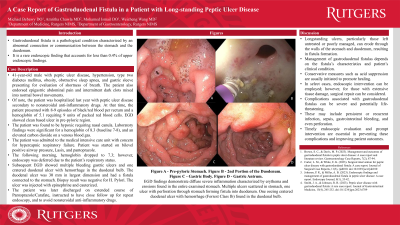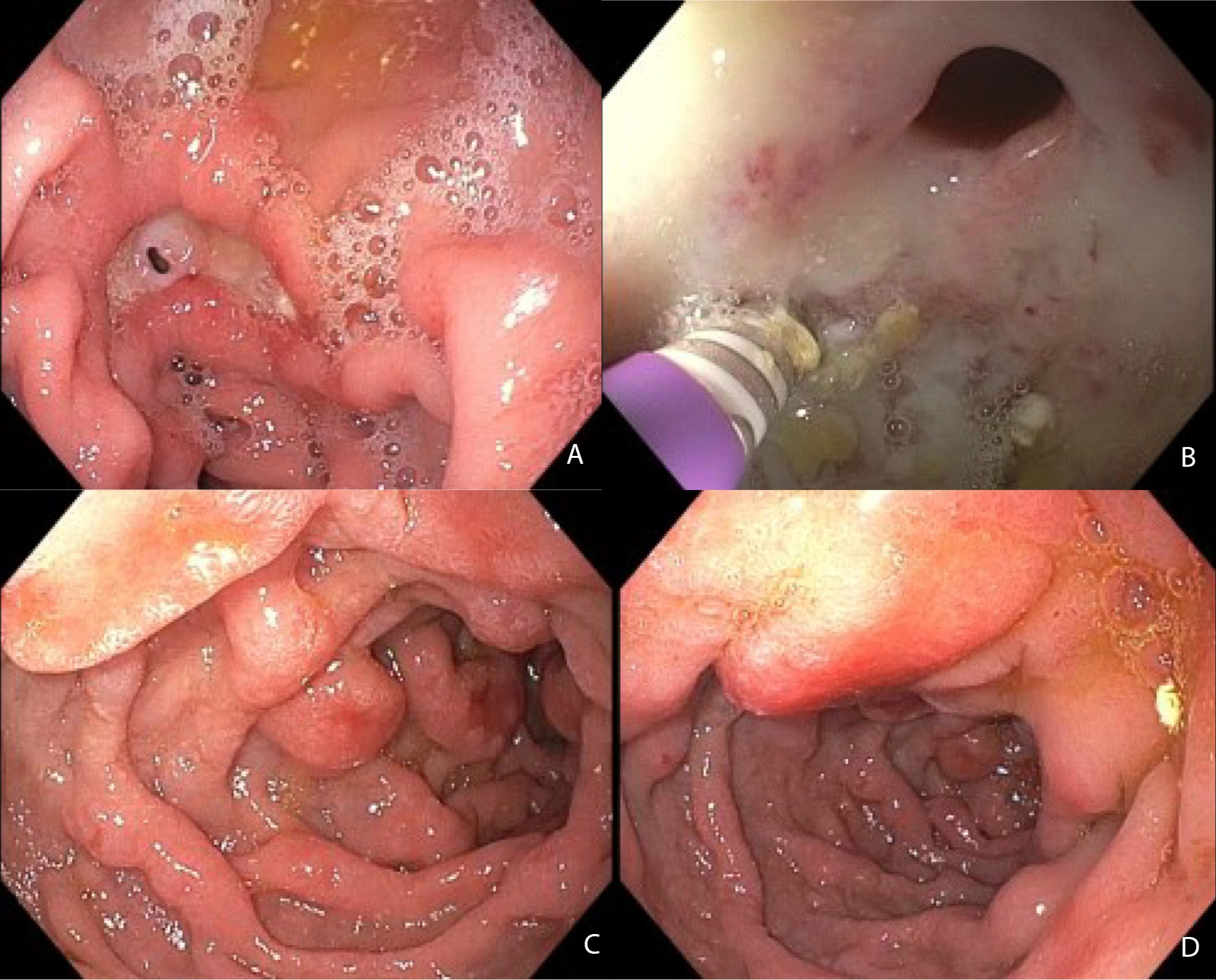Monday Poster Session
Category: Stomach
P2802 - A Case Report of Gastroduodenal Fistula in a Patient With Longstanding Peptic Ulcer Disease
Monday, October 23, 2023
10:30 AM - 4:15 PM PT
Location: Exhibit Hall

Has Audio

Michael Bebawy, DO
Rutgers New Jersey Medical School
Newark, NJ
Presenting Author(s)
Michael Bebawy, DO, Amrita Chawla, MD, Mohamed Ismail, DO, Weizheng Wang, MD
Rutgers New Jersey Medical School, Newark, NJ
Introduction: Gastroduodenal fistula is a pathological condition characterized by an abnormal connection or communication between the stomach and the duodenum. It is often a consequence of various underlying gastrointestinal disorders. It is a rare endoscopic finding that accounts for less than .4% of upper endoscopic findings.
Case Description/Methods: A 41-year-old male with peptic ulcer disease, hypertension, type two diabetes mellitus, obesity, obstructive sleep apnea, and gastric sleeve presented for evaluation of shortness of breath. The patient also endorsed epigastric abdominal pain and intermittent dark clots mixed into normal bowel movements. The patient was found to be hypoxic requiring nasal canula. Laboratory findings were significant for a hemoglobin of 8.3 (baseline 7-8), and an elevated carbon dioxide on a venous blood gas. The patient was admitted to the medical intensive care unit for concern for hypercapnic respiratory failure. Patient was started on bilevel positive airway pressure, Lasix, and pantoprazole. The following morning, hemoglobin dropped to 7.3; however, endoscopy was deferred due to the patient’s respiratory status. Subsequent EGD showed multiple bleeding gastric ulcers and one cratered duodenal ulcer with oozing hemorrhage (Forrest class 1b) in the duodenal bulb. The duodenal ulcer was 30 mm in largest dimension and had a fistula connected to stomach. Biopsy result was negative for H. Pylori. The ulcer was injected with epinephrine and cauterized. The patient was later discharged on extended course of Pantoprazole/Carafate, instructed to have close follow up for repeat endoscopy and to avoid nonsteroidal anti-inflammatory drugs.
Discussion: Longstanding ulcers, particularly those left untreated or poorly managed, can erode through the walls of the stomach and duodenum, resulting in fistula formation. Management of gastroduodenal fistulas depends on the fistula characteristics and patient’s clinical condition. Conservative measures such as acid suppression are usually initiated to promote healing. In select cases, endoscopic intervention can be employed; however, for those with extensive tissue damage, surgical repair can be considered. Complications associated with gastroduodenal fistulas can be severe and potentially life-threatening. These may include persistent or recurrent infection, sepsis, gastrointestinal bleeding, and even perforation. Timely endoscopic evaluation and prompt intervention are essential in preventing these complications and improving patient outcomes.

Disclosures:
Michael Bebawy, DO, Amrita Chawla, MD, Mohamed Ismail, DO, Weizheng Wang, MD. P2802 - A Case Report of Gastroduodenal Fistula in a Patient With Longstanding Peptic Ulcer Disease, ACG 2023 Annual Scientific Meeting Abstracts. Vancouver, BC, Canada: American College of Gastroenterology.
Rutgers New Jersey Medical School, Newark, NJ
Introduction: Gastroduodenal fistula is a pathological condition characterized by an abnormal connection or communication between the stomach and the duodenum. It is often a consequence of various underlying gastrointestinal disorders. It is a rare endoscopic finding that accounts for less than .4% of upper endoscopic findings.
Case Description/Methods: A 41-year-old male with peptic ulcer disease, hypertension, type two diabetes mellitus, obesity, obstructive sleep apnea, and gastric sleeve presented for evaluation of shortness of breath. The patient also endorsed epigastric abdominal pain and intermittent dark clots mixed into normal bowel movements. The patient was found to be hypoxic requiring nasal canula. Laboratory findings were significant for a hemoglobin of 8.3 (baseline 7-8), and an elevated carbon dioxide on a venous blood gas. The patient was admitted to the medical intensive care unit for concern for hypercapnic respiratory failure. Patient was started on bilevel positive airway pressure, Lasix, and pantoprazole. The following morning, hemoglobin dropped to 7.3; however, endoscopy was deferred due to the patient’s respiratory status. Subsequent EGD showed multiple bleeding gastric ulcers and one cratered duodenal ulcer with oozing hemorrhage (Forrest class 1b) in the duodenal bulb. The duodenal ulcer was 30 mm in largest dimension and had a fistula connected to stomach. Biopsy result was negative for H. Pylori. The ulcer was injected with epinephrine and cauterized. The patient was later discharged on extended course of Pantoprazole/Carafate, instructed to have close follow up for repeat endoscopy and to avoid nonsteroidal anti-inflammatory drugs.
Discussion: Longstanding ulcers, particularly those left untreated or poorly managed, can erode through the walls of the stomach and duodenum, resulting in fistula formation. Management of gastroduodenal fistulas depends on the fistula characteristics and patient’s clinical condition. Conservative measures such as acid suppression are usually initiated to promote healing. In select cases, endoscopic intervention can be employed; however, for those with extensive tissue damage, surgical repair can be considered. Complications associated with gastroduodenal fistulas can be severe and potentially life-threatening. These may include persistent or recurrent infection, sepsis, gastrointestinal bleeding, and even perforation. Timely endoscopic evaluation and prompt intervention are essential in preventing these complications and improving patient outcomes.

Figure: A - Pre-pyloric Stomach
B - 2nd Portion of the Duodenum
C - Gastric Body
D - Gastric Antrum
B - 2nd Portion of the Duodenum
C - Gastric Body
D - Gastric Antrum
Disclosures:
Michael Bebawy indicated no relevant financial relationships.
Amrita Chawla indicated no relevant financial relationships.
Mohamed Ismail indicated no relevant financial relationships.
Weizheng Wang indicated no relevant financial relationships.
Michael Bebawy, DO, Amrita Chawla, MD, Mohamed Ismail, DO, Weizheng Wang, MD. P2802 - A Case Report of Gastroduodenal Fistula in a Patient With Longstanding Peptic Ulcer Disease, ACG 2023 Annual Scientific Meeting Abstracts. Vancouver, BC, Canada: American College of Gastroenterology.
